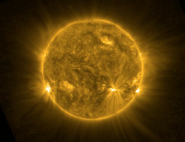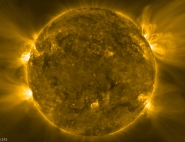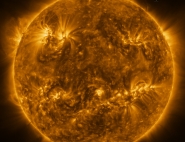Mission
Scientific Objectives
Since the beginning of the 1990's, six unprecedented spacecraft built in Europe for the Ulysses, SoHo and Cluster missions have made many amazing discoveries about the Sun, and how its storms affect the Earth. Yet, scientists still cannot predict the unruly behaviour of the star on which our lives depend. A closer look at the Sun is required.
Solar Orbiter is intended to brave the fierce heat and carry its telescopes to nearly one quarter of the Earth's distance from the Sun, where sunlight will be twenty times more intense than satellites in the vicinity of the Earth feel it. The spacecraft must also endure powerful bursts of atomic particles from explosions in the solar atmosphere. The reward will come in the form of sharp images obtained together with unprecedented measurements of the local near-Sun phenomena.
The pictures of the weird solar landscapes, where glowing gas dances and forms loops in the strong magnetic field, will be stunning. They will show details down to 200 kilometres wide, with a tiny fraction of the width of the Sun's visible disc, 1.4 million kilometres.
The scientific goals of Solar Orbiter are:
- to determine in-situ the properties and dynamics of plasma, fields and particles in the near-Sun heliosphere;
- to survey the fine detail of the Sun's magnetized atmosphere;
- to identify the links between activity on the Sun's surface and the resulting evolution of the corona and inner heliosphere, using solar co-rotation passes;
- to observe and characterize the Sun's polar regions and equatorial corona from high latitudes.
Mission
The currently foreseen scenario for launching Solar Orbiter is with a dedicated launch from Cape Canaveral with an Atlas V or Delta IV.
Orbit and commissioning
Following launch, Solar Orbiter will begin its journey to the Sun. This will require a cruise phase lasting approximately 3.4 years. During this time, the spacecraft will use a series of gravity assists from Venus and the Earth. This puts Solar Orbiter into a 168-day-long elliptical solar orbit from which it can begin its scientific mission. The payload will be commissioned during the cruise phase and will already be able to provide valuable science data. Upon entering the science orbit, closer encounters to the Sun will be achieved, with perihelion as low as 0.28 AU.
The spacecraft will perform a close approach of the Sun every five months. Around closest approach, when travelling at its fastest, Solar Orbiter will remain for several days roughly positioned over the same region of the solar atmosphere as the Sun rotates on its axis. Just as geostationary weather and telecommunications satellites are stationed over particular spots on the Earth's surface, so the spacecraft will seem to 'hover' for a while over the Sun. Solar Orbiter will therefore be able to watch storms building up in the atmosphere.
Ground controllers will repeatedly fly Solar Orbiter close to Venus, and use the planet's gravity to nudge the spacecraft into higher inclination orbits. This will enable the instruments to see the polar regions of the Sun clearly for the first time. This is one of the prime scientific goals of the project. After 7.4 years, Solar Orbiter will view the poles from solar latitudes higher than 30°, compared with 7° at best from the Earth.
![]()
Solar Orbiter observation modes along its orbit
The mission will be controlled from the European Space Operations Centre (ESOC), Darmstadt, Germany, using ESA's Malargüe ground station. The Science Operations will be managed from the European Space Astronomy Centre (ESAC), Madrid, Spain.


